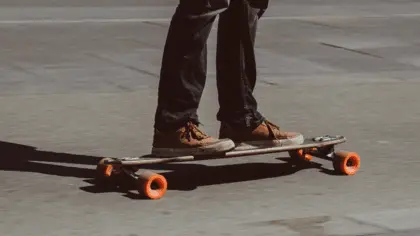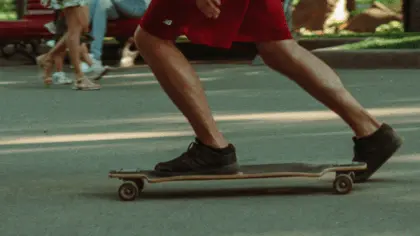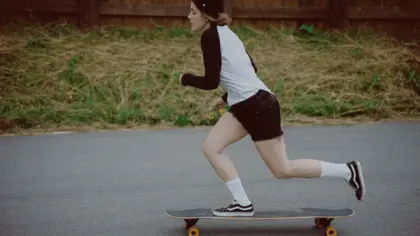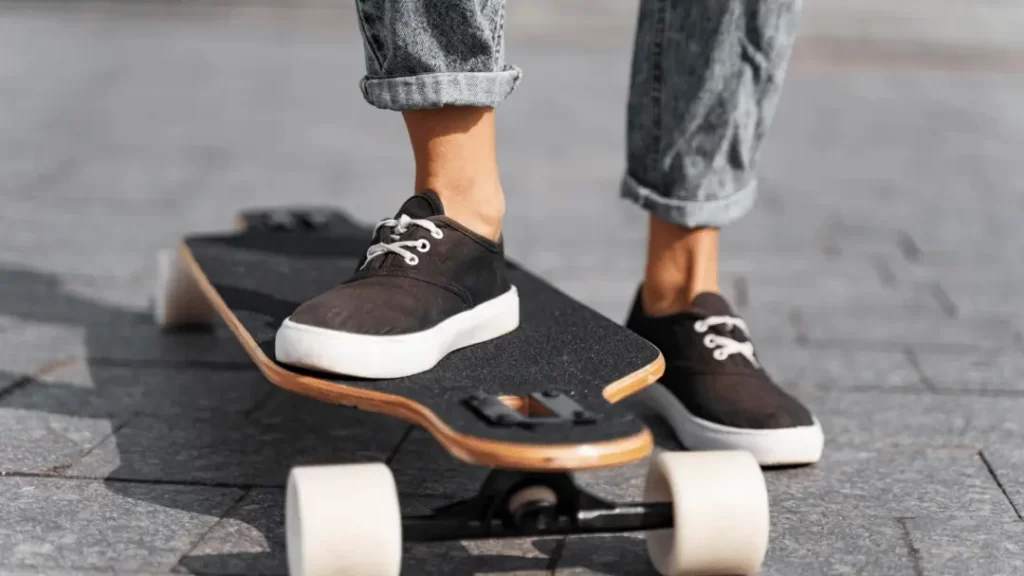A primary and fundamental part of the how-to-longboard learning curve is where to put your feet on a longboard. To be a longboard rider, knowing stance is essential. Stance refers to how you place your foot on the longboard and how you position your body when you ride.
There are several ways you can stand on a longboard and this will depend on what you are doing. For example, your stance, when you are riding casually, will differ from your stance when you are speeding downhill.
Besides the placement of your foot, your shoulders, hips, knees, and torso also determine your stance on a longboard. In this article, you will find comprehensive information regarding where to put your feet on a longboard. The article will also emphasize how to shape your other body parts so that you can stand effortlessly on your longboard.
Dominant foot and longboard stance

During longboard riding, one foot leads the other. Your body is arranged vertically to the direction of the motion of your longboard. And just as you have a dominant left or right hand, you also have a dominant foot.
You need to have your dominant foot on the back of the longboard. This is because your back foot is the pivot foot and it is responsible for most of the steering. It also gives you precision and control of your board.
The other foot will be in the front and provide direction and balance. So, first, you need to figure out your natural dominant foot to find out your natural stance.
Longboard has two different stances, and they are regular and goofy.
The regular stance is when you put your right foot back and left foot forward. This is known as the regular stance because the majority of the people have the right foot as the dominant one. So, they feel more comfortable in this position.
The remaining longboard riders put their right foot forward because their dominant foot is the left one. And that is called the goofy stance.
Your natural balance will dictate your stance. You need to figure out the dominant power holder between your right and left leg. There are also a few tests you can try to find out which one you are.
One way is to notice which foot you use naturally when kicking something. It is likely to be the dominant foot and that is the one you will want to have in the back of the longboard.
Another way is to ask someone to push you enough to make you lose your balance when standing. At that moment, you will unknowingly put a foot forward and that’s the dominant one.
You can also try to pull something hard. When you do so, notice which foot you use to get more pull. That foot will be on the back of your longboard.
Since the different style of riding requires a different style of positioning, here are some of them to help you understand where to put your feet on a longboard.
Also Read: How fast can you go on a longboard?
Stance on a longboard for cruising

Now you know what kind of rider are you; regular or goofy. Below you will find out how you should stand while relaxingly cruising around at a moderate speed.
Where to put your feet on a longboard
For normal cruising, you want to put your feet a little wider than your shoulder-width and have them at the same distance from your back and front trucks.
In terms of the width, you need to have your feet in the center of the deck. Have your front foot almost at a 45º angle and your back foot at a perpendicular position to the back.
Positioning knees
You want to have a relaxed stance while cruising as you might stay in this position for hours. You just have to slightly bend your knees. This will allow you to control your balance as well as absorb minor shocks.
Positioning of shoulders and hips
In the stance for cruising longboard, your hips will face perpendicular to the board or you can subtly rotate your body to face forward. Typically, the shoulders follow the hips and face in a similar direction.
Positioning of torso
The positioning of your torso in the cruising stance is almost neutral. It doesn’t need to lean backward or forward. However, if you come across a crack or bump, you will need to bend your knees and lean forward to control your balance.
Related Article: What is the best loaded longboard for cruising?
Stance on a longboard for carving
Carving is a technical riding stance that greatly relies on figuring out the proper stance.
Where to put your feet on a longboard
Carving requires you to frequently shift your weight between your heels and toes and make continuous turns.
Both your back and front foot needs to be located across the board in a perpendicular position in a carving stance.
Positioning knees
Carving stance requires you to keep swapping your knees between straight and flex positions before as well as after each turn or carve. You need to lower the center of gravity to compress when making the carve and then arise and decompress on the finish. This will transfer energy into the longboard.
Positioning of shoulders and hips
Your turns will dictate the rotating of your upper body. You will have to rotate your head, hips, ankle, and shoulders in a fluid motion.
Positioning of torso
Generally, one leans forward when carving to keep the balance during turns. You need to bend at the waist while shifting your body back and forth.
Stance on a longboard for pushing

Your stance needs to be different than the previous two for pushing on a longboard to gain speed.
Where to put your feet on a longboard
Riders mostly use their dominant foot to push while steering with and balancing on the other foot. You will want to put your front foot parallelly to the deck, ahead of the forward truck bolts, and facing in the direction of the nose.
Some riders choose a reverse stance where they balance their board with the dominant or back foot, placing it near the rear truck, and using the front foot to push the longboard.
Related truck: Best longboard trucks reviews
Positioning knees
In the pushing stance, you basically squat down on your front or back leg, depending on your preference. Then you bend the knee to get the other hanging foot lower and push the ground with it. While trying to gain some power, the pushing knee also bends down quite a bit.
Positioning of shoulders and hips
Since you position both of your feet parallelly to the deck in a pushing stance, you position your shoulders and hips in the direction of the motion of your board – facing straight forward.
Positioning of torso
When you push the longboard with your preferred leg, you also lean forward your torso in the course of the motion. You also bend at the hips to balance your pushing while trying to get power and stability.
While you push forward, you may instinctively bring up your torso, but you should again lean forward to get a more solid push.
Stance on a longboard for speed
You need to master a special stance for speed riding. It is known as a “tuck”. Tucking refers to a body position where wind resistance is minimized and stability is maximized at speed.
Where to put your feet on a longboard
In the tuck stance, you will have to place your front foot slightly angled in the deck and near the front truck mount.
At this stance, the back foot needs to be paralleled to the front foot while slightly angled. Keep about a one-foot length of distance between the two feet. And rest the rear foot on its toes. Keep the toes near the edge of the board, this will allow you to turn the front side easily.
Positioning knees
Bend your knees about 90º. Your weight will mostly be on the front leg and the back knee will lean towards your front calf. This will happen naturally when you will have your back foot stand on its toes.
Positioning of shoulders and hips
For the speed stance, you need to rotate your shoulders forward, facing downhill. Your hips should be facing forward. Also, stretch your front hip to allow your back knee to tuck under the front knee.
Positioning of torso
Bend your torso almost horizontally forward and have your chest lean against the front thigh. And tuck your arms behind your back. This is to minimize the surface the wind can hit.
Where to put your feet on a longboard for foot braking
The way you balance and push on the front leg while pointing your foot toward the nose is the same way you do a foot-braking stance. You will face your upper body forward and slightly squad down to put your back foot to the ground slightly ahead of or parallelly to the standing foot.
For foot braking, you use your middle foot and back heel to sweep against the ground instead of pushing it. Keep your toes slightly lifted so that you don’t hit a bump.
Final thoughts
Where to put your feet on a longboard depends on how you are riding. Longboard stances vary, so you need to practice more and more to be able to naturally get into the proper posture. Think about what you are doing and practice the abovementioned stances. You should develop an instinct for stance after a while. Build up your balancing skills and over time, you will naturally figure out where to put your feet on a longboard.

Hi, my name is Gabriel. I am completed my MBA from private university and my subject was IT (Information Technology) and also I complete my graduation form South East University and Department from CSE (Computer Science & Engineering). I am author and blogger of this website who loves to write about different topics that are related to the board sport. From beginner tips to intermediate advice, I want to offer you quality content that will help improve your skill set and make you a better rider. Thanks for checking out my site!
